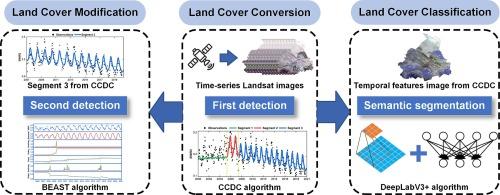利用卫星时间序列进行连续土地覆被变化监测和语义分割的快速混合方法
IF 7.6
Q1 REMOTE SENSING
International journal of applied earth observation and geoinformation : ITC journal
Pub Date : 2024-10-17
DOI:10.1016/j.jag.2024.104222
引用次数: 0
摘要
土地覆被变化检测和分类,包括类间变化(土地覆被转换,LCC)和类内变化(土地覆被改良,LCM),对于了解地球的动态过程和促进可持续性至关重要。然而,以往的研究主要侧重于土地覆被转换,而较少关注土地覆被改良。土地覆被分类仍然具有挑战性,其绘图结果经常受到椒盐噪声的影响。在此,我们以中国金昌市为例,提出了一种土地覆被连续变化检测和分类的混合方法。首先,我们将连续变化检测和分类(CCDC)算法与突变、季节变化和趋势贝叶斯估计(BEAST)算法相结合,利用 2000 年至 2020 年的所有可用陆地卫星时间序列(TS)数据来识别 LCC 和 LCM。然后,将 CCDC 得出的谐波回归系数和均方根误差值(以下称为 CCDC 特征)输入 DCNN 模型,用于 LCC 分类。我们的研究结果表明:(1)在 LCC 和 LCM 准确度评估中,CCDC 和 BEAST 组合的空间 F1 得分为 82.7%,平均时间 F1 得分为 79.7%。(2)在土地覆被分类中,具有 CCDC 特征的 DCNN 模型,特别是 DeepLabV3+ 的表现优于基于像素的 XGBoost 和其他多年期土地覆被产品,其频率加权交集大于联合(FWIoU)、总体准确率和 Kappa 分数分别为 88.7%、94% 和 0.87。(3) 与趋势 LCM 相比,季节 LCM 的分布更为集中。(4) 在金昌市,LCM 的面积大于 LCC,草地和耕地分布最广。我们的方法可用于地表监测,提高土地管理能力。本文章由计算机程序翻译,如有差异,请以英文原文为准。

A fast hybrid approach for continuous land cover change monitoring and semantic segmentation using satellite time series
Land cover change detection and classification, including both inter-class changes (land cover conversion, LCC) and intra-class changes (land cover modification, LCM), is critical for understanding the Earth’s dynamic processes and promoting sustainability. However, previous studies have predominantly focused on LCC, with less emphasis on LCM. Land cover classification remains challenging, and its mapping results are often affected by salt and pepper noise. Here, we propose a hybrid approach for continuous change detection and classification of LCC and LCM using Jinchang City, China, as a case study. Firstly, we combined the Continuous Change Detection and Classification (CCDC) and the Bayesian Estimator of Abrupt change, Seasonal change, and Trend (BEAST) algorithms to identify LCC and LCM using all available Landsat time series (TS) data from 2000 to 2020. Then, the harmonic regression coefficients and RMSE values derived from CCDC (hereafter called CCDC features) were fed into the DCNN model for LCC classification. Our findings indicate: (1) For LCC and LCM accuracy assessment, the CCDC and BEAST ensemble achieved a spatial F1 score of 82.7% and an average temporal F1 score of 79.7%. (2) In LCC classification, the DCNN model with CCDC features, particularly DeepLabV3+, outperformed the pixel-based XGBoost and other multi-year land cover products, with frequency-weighted intersection over union (FWIoU), overall accuracy, and Kappa scores of 88.7%, 94%, and 0.87, respectively. (3) Seasonal LCM showed a more concentrated distribution than trend LCM. (4) In Jinchang City, LCM larger than LCC in area, and grassland and cultivated land are the most distributed. Our approach can be contributed to wall-to-wall land surface monitoring and enhance land management capabilities.
求助全文
通过发布文献求助,成功后即可免费获取论文全文。
去求助
来源期刊

International journal of applied earth observation and geoinformation : ITC journal
Global and Planetary Change, Management, Monitoring, Policy and Law, Earth-Surface Processes, Computers in Earth Sciences
CiteScore
12.00
自引率
0.00%
发文量
0
审稿时长
77 days
期刊介绍:
The International Journal of Applied Earth Observation and Geoinformation publishes original papers that utilize earth observation data for natural resource and environmental inventory and management. These data primarily originate from remote sensing platforms, including satellites and aircraft, supplemented by surface and subsurface measurements. Addressing natural resources such as forests, agricultural land, soils, and water, as well as environmental concerns like biodiversity, land degradation, and hazards, the journal explores conceptual and data-driven approaches. It covers geoinformation themes like capturing, databasing, visualization, interpretation, data quality, and spatial uncertainty.
 求助内容:
求助内容: 应助结果提醒方式:
应助结果提醒方式:


